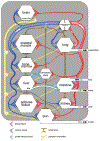Biology-inspired microphysiological systems to advance patient benefit and animal welfare in drug development
- PMID: 32113184
- PMCID: PMC7863570
- DOI: 10.14573/altex.2001241
Biology-inspired microphysiological systems to advance patient benefit and animal welfare in drug development
Abstract
The first microfluidic microphysiological systems (MPS) entered the academic scene more than 15 years ago and were considered an enabling technology to human (patho)biology in vitro and, therefore, provide alternative approaches to laboratory animals in pharmaceutical drug development and academic research. Nowadays, the field generates more than a thousand scientific publications per year. Despite the MPS hype in academia and by platform providers, which says this technology is about to reshape the entire in vitro culture landscape in basic and applied research, MPS approaches have neither been widely adopted by the pharmaceutical industry yet nor reached regulated drug authorization processes at all. Here, 46 leading experts from all stakeholders - academia, MPS supplier industry, pharmaceutical and consumer products industries, and leading regulatory agencies - worldwide have analyzed existing challenges and hurdles along the MPS-based assay life cycle in a second workshop of this kind in June 2019. They identified that the level of qualification of MPS-based assays for a given context of use and a communication gap between stakeholders are the major challenges for industrial adoption by end-users. Finally, a regulatory acceptance dilemma exists against that background. This t4 report elaborates on these findings in detail and summarizes solutions how to overcome the roadblocks. It provides recommendations and a roadmap towards regulatory accepted MPS-based models and assays for patients' benefit and further laboratory animal reduction in drug development. Finally, experts highlighted the potential of MPS-based human disease models to feedback into laboratory animal replacement in basic life science research.
Keywords: assay qualification; drug testing; iPSC-derived organoids; industrial adoption; microphysiological systems; multi-organ-chip; organ-on-chip; organoids; regulatory acceptance.
Conflict of interest statement
Conflict of interest
Murat Cirit is shareholder and CEO of Javelin Biotech, Inc. Olivier Frey is part of the management team at InSphero, which commercializes MPS platforms. Thomas Hartung is named inventor on Johns Hopkins’ patent application for a BrainSphere model, licensed to AxoSim Inc., New Orleans, LA, where he serves as Consulting Vice President of Scientific Affairs, holding shares of the company. David Hughes is an employee and holds stock in CN Bio Innovations Ltd, which commercializes MPS platforms. Donald E. Ingber holds equity in Emulate Inc. and chairs its Scientific Advisory Board; he also consults to Roche. Uwe Marx is shareholder and CEO of TissUse GmbH, which commercializes MPS platforms. Thomas Neumann is shareholder and CEO of Nortis, Inc., which commercializes MPS platforms.
Figures












References
-
- Balls M, Blaauboer B, Brusick D et al. (1990). Report and recommendations of the CAAT/ERGATT workshop on the validation of toxicity test procedures. Altern Lab Anim 18, 313–337.
MeSH terms
Grants and funding
LinkOut - more resources
Full Text Sources
Miscellaneous

